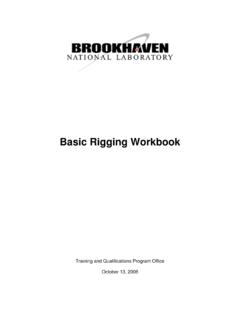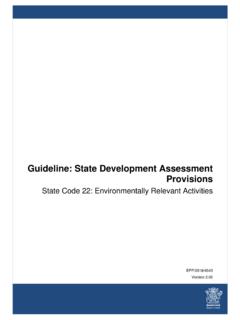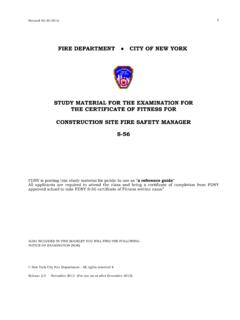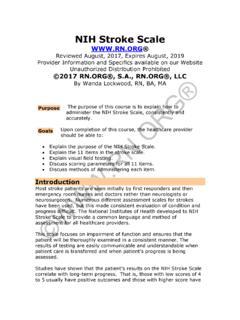Transcription of Basic Rigging BNL Workbook 2008-10-13
1 Basic Rigging Workbook Training and Qualifications Program Office October 13, 2008. -2- Table of Contents Determine Task and Job-Site 4. Characterize the Load .. 7. Specify, Select, and Inspect Rigging 15. Wire Rope Slings .. 15. Synthetic Slings .. 19. 21. Shackles .. 22. Eye 24. Hoist Rings .. 26. Turnbuckles .. 28. Using Rope in Rigging Applications .. 29. Lift, Maneuver, and Move 31. Handling Symmetrical Loads .. 31. Handling Asymmetrical Loads .. 32. Moving Loads through Vertical Openings .. 33. Moving Loads through Horizontal Openings.
2 34. Moving Loads around or over Obstacles .. 35. Moving Loads in Close Proximities .. 36. Upending, Inverting, and Rolling Loads .. 38. Lifting with Hand-Operated Chain Hoists .. 39. Appendices .. 42. Carbon Steel Pipe Size Chart .. 43. Weight of Common 44. Hand Signals .. 45. -3- Determine Task and Job-Site Requirements In order to ensure the safety of workers and the equipment involved, any operation involving the use of a crane to lift items must be planned thoroughly before being carried out. The purpose of this document is to discuss the requirements for planning and performing an incidental lift using an overhead crane and commonly available Rigging components, such as slings, shackles, eye bolts, and turnbuckles.
3 The "Lifting Safety" Subject Area, found in the Brookhaven National Laboratory (BNL). Standards-Based Management System (SBMS), governs all lifts conducted at BNL. The Subject Area contains guidance that must be used in order to plan and perform a lift safely. This instructor handbook incorporates the Subject Area's requirements, as well as information from the Department of Energy's (DOE's) Hoisting and Rigging Manual and ANSI Definitions Asymmetrical load. An object with an off-center center of gravity due to the object's irregular shape and/or composition.
4 Critical lifts require confirmation of engineering, or merit additional engineering input because of an item's or location's size, weight, close-tolerance installation, or high susceptibility to damage. These lifts could be either ordinary lifts or pre-engineered lifts, but with additional hazards that could result in significant delays to a program, undetectable damage resulting in future operational or safety problems, a significant release of radioactivity or other hazardous material, present a risk of injury personnel.
5 Critical lifts must be made by Plant Engineering riggers or by approved contractors, and as such are not covered in this program. Incidental or ordinary lifts involve the use of Basic hoisting equipment directly above the load. The load must also have certified lifting points or be relatively easy to sling. Person-in-charge. Person appointed by the responsible manager or designee to direct critical or pre-engineered lifts. The person-in-charge must be present during the entire lifting operation and must have experience in handling similar types of equipment.
6 The designated person-in-charge may be either a supervisor familiar with critical lift operations, or a person with special knowledge of the equipment and handling. Pre-engineered lifts are repetitive lifts that meet the definition of a critical lift, defined below. If, however, the BNL Lifting Safety Committee determines that through the use of tooling, fixtures, sketches, analyses, and written procedures, the possibility of dropping, upset, or collision is reduced to an acceptable level, the lift may be designated as a pre-engineered lift.
7 Symmetrical load. An object that, because of its uniform shape and composition, has its center of gravity located exactly in its middle. -4- Classifying Lifts Before a lift can be planned, it must be analyzed to determine the lift's category. There are three lift categories at BNL: incidental or ordinary lifts, pre-engineered lifts, and critical lifts. The responsible manager or designee determines the type of lift by conducting a lift assessment. The flow chart here, adapted from the SBMS Lifting Safety Subject Area, will help to determine if a lift should be classified as incidental (ordinary), pre-engineered, or critical.
8 Refer to the Subject Area for additional guidance. -5- If the lift has been classified as a pre-engineered lift, then additional criteria must be met prior to operation. If determined to be a critical lift, Plant Engineering riggers or an approved contractor must be used. Once the lift has been classified and determined to be an ordinary or incidental lift, use the Checklist for Lift Planning and Weather Factors exhibits, found in the Lifting Safety Subject Area, as tools for evaluating the area of operation and potential.
9 Ordinary Lift Plan Elements Once a lift has been planned and approved, the appropriate Rigging equipment, including slings, shackles, turnbuckles, and the crane itself, must be selected, inspected, and connected correctly prior to beginning the lift itself. The following items must be checked and confirmed before selecting Rigging components: Weight of lift Sharp corners and angles on load Center of Gravity Sling angles Lift points Load angle factor Crane capacity Travel route clearance Speed, height, width, and length of lift Floor loading capacity Wind, temperature, and visibility Work zone safety Crane and Load foundation ratings Planning and Performing Pre-Engineered Lifts Pre-engineered lifts are repetitive lifts that meet the definition of a critical lift, defined below.
10 If, however, the BNL Lifting Safety Committee determines that through the use of tooling, fixtures, sketches, analyses, and written procedures, the possibility of dropping, upset, or collision is reduced to an acceptable level, the lift may be designated as a pre-engineered lift. A Pre-Engineered Lift Plan must be completed and submitted to the Lifting Safety Committee chair prior to any work being performed. The Plan consists of as many drawings, specifications, and procedures as necessary to assess all important load factors and site factors relating to the lift.






